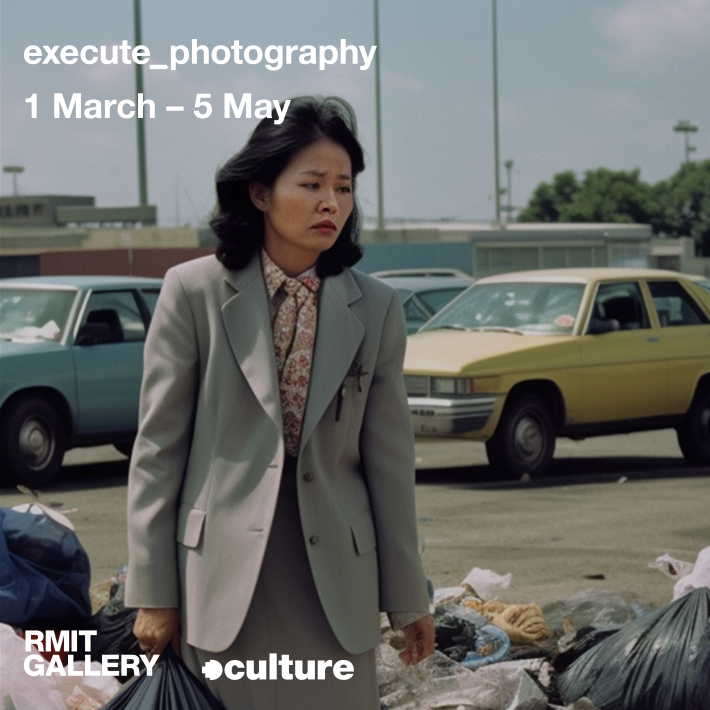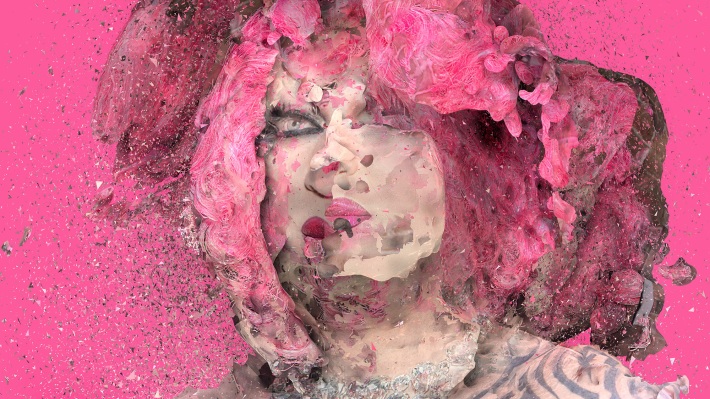
execute_photography [curatorium]
Bennett, Hulbert, Palmer & Sluis (curators), execute_photography, RMIT Gallery for PHOTO 2024, 1 March – 5 May 2024 Photography is constantly dying andbeing reborn. AI represents the latest stage of photography’s transformation into a software output, cannibalising the camera and

Marshmallow Laser Feast [exhibition review]
Bennett 2024, ‘Marshmallow Laser Feast: Works of Nature'[exhibition review], Artlink online 21 Feb 2024

expanded photography, 2020 – present
photogrammetry webXR explorations of plants as celestial encounters and building interiors as containers of space and memory

Skin: neuroqueer entanglement, 2019
SKIN takes the form of a large-scale photographic artwork that wraps the skin of tattooed neuro-diverse LGBTQIA+ people around the digital facade of Fed Square.

Lain, 2018
The camera is a tool to recalibrate our relationship and rewrite the imprint of the intense extended looking of a parent gazing at their child. Shortlisted for the Bowness Photography Prize.

The Black Box Experiment, 2018
Step inside the Black Box and be transported to a virtual mirror world. In the space of mere minutes, you will be scanned and rendered as a 3D model, then placed into a digital version of the Testing Grounds site. Here you may encounter magnificent animated toys inhabiting the space as the sky mutates through a deep dream of algorithmic horizons.

QUEERTECH.IO = ART(URL, IRL); 2018
QueerTech.io 2018! Themes emerging from the 2018 selection include digitally-born queer utopias, queer re-imaginings of computer game platforms, and interactive works that extend the digital as a queer prosthesis. The project features over twenty five artists engaged in making neural

I am looking in a room, 2017
“This work was made in response to the location, standing on Hopkins Street looking up into the windows of the Trocadero Art Space studios. I was interested in the somewhat voyeuristic feeling of peering up into a lit window at night and, in turn, attempting to connect with the street life on the footpath below.
During the making of the work, the first subject simply pulled out their phone and ignored the camera. They then introduced me to Alvin Lucier’s astounding 1969 sound artwork ‘I am sitting in a room’. The second subject improvised choreography in response to that artwork.
I have a long-standing interest in the cultural convergence of screens, windows and image frames, as articulated by Friedberg (2006) in ‘The Virtual Window: Alberti to Microsoft’. I wanted to explore the ambiguous and shifting positions between looking in and looking out, the feeling of being inside and outside, hence the title ‘I am looking in a room’, with a hat tip to Lucier.”
This four-channel video work was commissioned by the West Projections Festival 2017.

muliebrity, 2017
“The word ‘muliebrity’ means ‘female qualities’. This 3d video work reflects on feminine identity expression by queer women. It is somewhat of a stereotype that lesbians and queer women express their gender identity in what might be considered as androgynous, masculine or butch. But there are also those that feel most authentic when they express their gender in more traditionally feminine ways. The paradox is that those women are often ‘read’ as heterosexual – so whilst their femininity is visible in the way that their identity is reflected, their queerness is invisible. Working with Jill Soloway’s conception of the female gaze, this work is an encounter with a series of faces that might provoke the viewer to reflect on how they read identity presentation.”
Muliebrity was commissioned by Kingston Arts for the Midsumma Festival 2017.

Virtual Drag, 2016
The intersections between virtuality and drag stem from ways of speaking about virtual reality as simulation and the drag definition of ‘realness’. Featuring photogrammetry models of drag performers in fantasy virtual reality environments, Virtual Drag has been shown at numerous international festivals such as Videonale Festival at the Kunstmuseum in Bonn and Twist360 in Seattle. It was included in Screen NSW VR showcase 360Vision and the groundbreaking publication The Additivists Cookbook, a compendium of artistic strategies utilizing 3D technology for activism. Virtual Drag generated a small buzz internationally in new media art circles, reviewed in Motherboard, KillScreen, The Creators’ Project & Prosthetic Knowledge . This project was assisted by the Australian Government through the Australia Council for the Arts, its arts funding and advisory body, Deakin Motion.Lab & Media Lab Melbourne.

Wrap series, 2014-2017
This series of online interactive & touch screen works considers the convergence of biological & digital skin as virtual prosthesis. Reworlding (Elizabeth) was awarded for Innovative Use of Digital Media at the 2016 CCP Salon & included in ‘Crossroads’ at the San Francisco Museum of Modern Art, & long-listed for the 2017 Lumen Prize at V&A Digital Futures. Bruise, exhibited at RMIT Gallery as part of ‘Morbis Artis’, featured in an article about bio art on CNN. Works from the Wrap series were included in #nfcdab wrocław biennale of digital & internet art in Poland.

Inverto, 2014
‘Inverto’ is Latin for transform/transfer/transpose, and curiously, ‘invert’ is an old term for homosexual that carries transgender implications. Inverto is a series of photographs taken monthly over two years bearing witness to an individual undertaking the process of physically aligning gender identity with embodied presence. The images demonstrate the impact of hormone therapy and gender reassignment surgery following pregnancy over a period of two years. Inverto featured on ABC TV Australian Story ‘From Daddy’s Tummy’ and generated international viral media attention in dozens of languages that included the New York Times. Inverto #19 won the CCP Salon portraiture award and was included in The Guardian roundup of best Australian photographs of 2015. International exhibitions include the FILE Festival in Brazil, Harman Centre Gallery at Bradley University in Chicago and The Wrong Biennale.

Shifting Skin, 2013
Shifting Skin is an elegant statement on the collapsing boundaries between material and virtual via the connecting metaphor of skin. The uncannily flattened images of human surface were captured using a re-purposed flatbed scanner held directly against the subject’s body. When viewed through an app on a mobile screen, a 3D topography appears to project out of the print, a landscape of peaks and valleys describing the tonal scale within the surface of the subject, the terrain of scars, tattoos, skin tone and texture. Shifting Skin generated considerable international attention stemming from a retweet by cyberpunk author William Gibson and a report by Mashable.com that appeared in the Huffington Post. Shifting Skin toured regional Victorian galleries; was shown at the Cork Film Centre, Ireland & Theorizing the Web conference in NYC.

Stiched panoramas of interiors, 2004-2010
I am interested in the ‘shudder’ one experiences when encountering a room that has resonance; that has duration; where past, present and future collapse. ‘Interiority’ is a term that traverses a number of relevant fields. In architecture it is used to describe the experience of being in an interior space; in psychology it refers to one’s interior life, what it feels like inside your head or body. I seek to fold together the collapse between ‘what it feels like inside this room’, ‘what it feels like inside my head’ and the space of the camera in that process of encounter. These works have been shown at the Historic Houses Trust in Sydney, National Wool Museum in Geelong, Warrnambool Art Gallery, Horsham Regional Art Gallery; and ANU School of Art Gallery as part of the Vivid National Photography Festival. Media coverage and reviews include The Age, un magazine, Artichoke, Arena, Architecture Australia & antiTHESIS journal.
